Messines: June 1917
MESSINES: IRISH BROTHERS IN ARMS?
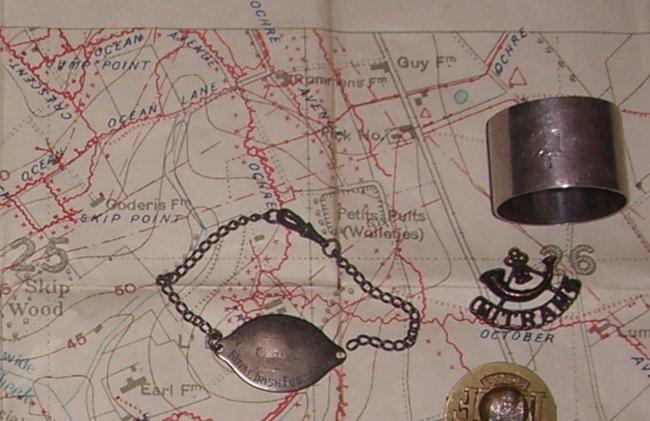
On 22 July 1920 William Dunning from the Shankill Road had ‘practically the left side of his head blown off’ during sectarian violence in Belfast, he died instantly. Dunning was a Protestant who had served during the First World War (FWW). Two years later on 1 April 1922 Joseph Walshe was shot dead in his bed in front of his two young children. Walshe was a Catholic who had served during the FWW. These are just two examples from a bitterly violent and sectarian period in Belfast which resulted in 498 deaths in two years 1920-22. Yet on Wednesday 7 June 2017 the nation will mark the centenary of the Battle of Messines Ridge (First World War), a battle that has acquired an almost mythical status in Ireland as a result of the ‘side by side’ attack of the largely Catholic 16th (Irish) and the largely Protestant 36th (Ulster) Divisions on 7 June 1917. The striking symbolism of these two volunteer divisions co-operating and advancing ‘side by side’ in 1917 led Messines to be deliberately selected as a site on which peace and reconciliation can be promoted in Northern Ireland, particularly since 1998. The 16thand 36th Divisions were, of course, recruited largely from the nationalist Irish Volunteers and the unionist Ulster Volunteer Force, two volunteer armies that could potentially have been at war with one another just three years earlier during the home rule crisis. Furthermore, the death in battle of nationalist MP Major Willie Redmond, who was tended to by John Meeke of the Ulster Division, has, in recent years, served to encapsulate the reconciliatory spirit of Messines. Of course, unionists and nationalists had been serving side by side since the beginning of the war in regular units of the army and, for example, in the 10th (Irish) Division. In East Belfast there were many men from streets in the Short Strand area serving in the 1st and 2nd Royal Irish Rifles, not to mention Peter and Thomas Rooney of Kilmood Street, two Catholic lads who served in the Ulster Division with the 14th R. Ir. Rifles. Unionists and nationalists serving side by side was certainly nothing new by June 1917.
The German army had occupied the Messines Ridge area since 1914 and it provided them with an excellent vantage point on an area of high ground. The allies believed that by taking the ridge, and the German strong point of Wytschaete, they could gain an initiative. It is evident that harsh lessons had been learned from the catastrophic losses of 1916. Preparations were more intense and several tactical components were combined to good effect. Mining on this occasion was particularly successful. In preparation for an assault on the ridge, tunnels had been dug underneath the German lines and were packed with approximately 500 tons of high explosives. Eight days of intense bombardment saw 3.5 million shells rain down on the German positions, this was followed by an infantry advance under a ‘creeping barrage’ that was supplemented by aeroplanes and tanks. The decision to place the 16th and 36th Divisions in close proximity was purely a military one. Indeed, the Divisions might have been amalgamated had it not been for the political opposition at home from Edward Carson and John Redmond. Nevertheless, there are examples of both good and bad relations between the men of the two Divisions and it would be wrong to suggest that political and religious feeling had dissipated on the Western Front.
During the month of May 1917 the 8th Battalion Royal Irish Rifles (East Belfast Volunteers) had been practising attacks over dummy trenches in preparation for the attack on 7 June. On the evening of 6 June, the men of the battalion were noted in the unit war diary as being ‘remarkably cheery’. At ‘zero hour’ (03:10) the tunnelled mines were detonated resulting in horrific consequences that succeeded in dislodging the Germans from the hills. It was said that the mines could be felt and heard as far away as London. The Germans appear to have been taken by surprise by the assault, presumably due to the unconventional timing of the attack. The mines caused huge craters that, in some cases, led the men to lose their direction in the early stages of the attack. In one instance the barbed wire was found to be inadequately cut and Lance Corporal J. A. Armour of the 8th R. Ir. Rifles rushed forward into the barrage and under enemy machine gun fire to cut a passage through the German wire. At another location, as the 8th Battalion advanced through its objectives, the situation appears to have got confused. ‘I found there men of three Divisions all mixed up with my men… there were parties of all units wandering about on my flanks, apparently lost and not knowing where they were.’ (A.J.P. Thornton, Captain & Adjutant, 8th Royal Irish Rifles).
Nevertheless, as the battle unfolded the 16th (Irish) and 36th (Ulster) Divisions fought in close proximity and successfully achieved their objectives by early morning on 7 June. At this point, the 8th R. Ir. Rifles were relieved by the 12th Royal Irish Rifles (Central Antrim Volunteers) and withdrawn to bivouacs at Fort Victoria. Upon arrival at their camp, the Commanding Officer Cole-Hamilton congratulated them on their fine performance and excellent work during the attack.
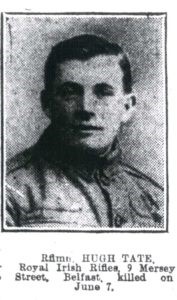
With thanks to Maria Higgins
The Commonwealth War Graves Commission cites 39 men of the 8th R. Ir. Rifles who died on 7th/8th June 1917. One of these men was Rifleman Hugh Tate. Aged 30, Tate resided at 9 Mersey Street with his wife Sarah. He served in ‘A’ Company of the 8th R. Ir. Rifles and is buried at Lone Tree Cemetery, Belgium (thanks to Maria Higgins for the image of Hugh Tate). East Belfast men also died at Messines serving in units besides the 8th R. Ir. Rifles, for example Rifleman William Spence of 203 Albertbridge Road who served with ‘D’ Company of the 14th R. Ir. Rifles, or Second Lieutenant Brian Boyd MM also of the 14thR. Ir. Rifles. Boyd, aged just 19, went over the top on 7 June carrying the battalion flag and was one of the first to fall. He resided at 10 Cyprus Gardens and was a member of the 10th(Belfast) Scout Troop. One of Boyd’s scout colleagues said of him: ‘Brian was almost the ideal scout, and was devoted heart and soul to the 10th, which he loved, and to which he hoped to return as an officer’. Today, Brian Boyd is commemorated on the Strandtown Unionist Club Memorial (Belmont Road) and at Bloomfield Presbyterian Church. Another example is Second Lieutenant Edwin Samuel McCullagh of Rosetta Park who served with the 14th Cheshire Regiment. Ironically the 8th R. Ir. Rifles complained in their war diary that during the confusion of the battle the Cheshires had mistakenly found themselves in trenches that were supposed to be occupied by the 8th R. Ir. Rifles.
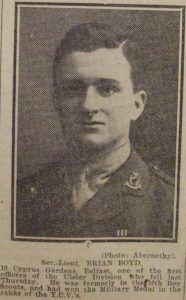
The best known fatality from Messines is, however, not connected to East Belfast. Major Willie Redmond was a 56 year old Irish Nationalist MP for East Clare who was wounded within minutes of leaving his trench with the 16th (Irish) Division. He was not required to go over the top with his men at Messines but had specifically requested to do so. Redmond’s unit advanced adjacently with the 11th Battalion Royal Inniskilling Fusiliers of the Ulster Division and it was an Ulster Division stretcher-bearer who managed to make his way to the wounded Major and bring him to a casualty clearing station. Willie Redmond died a short time later and the stretcher-bearer, John Meeke, received the Military Medal for his bravery. Redmond had previously expressed some hope that unionist and nationalist co-operation during the war might create a more positive spirit for the future, and, ultimately lead to home rule for Ireland. It is fitting, therefore, that his final moments were a dramatic act of reconciliation when an Ulster unionist made a desperate attempt to save the life of an Irish nationalist MP.
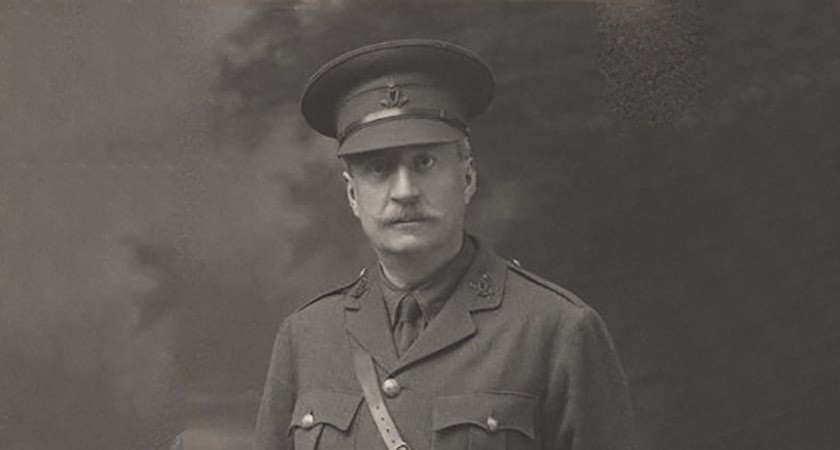
Major William Redmond MP
However, not everyone agreed with how this symbolism was being used at home. One unionist wrote to the Belfast News Letter soon after the battle to suggest, somewhat sarcastically, that ‘it transpires that after all there were some other heroes fighting along with the late Major W. Redmond… [we] might have been led to believe that the gallant Major had not only engineered the magnificent upheaval which heralded the victory, but that he had, single handed, routed the enemy… Had he not met his death at a time when the [newspapers] were badly in need of a stimulant the casualty would have been listed in the ordinary way… the singling of him out for a national funeral is an insult to the memories of the many other Irish officers who have gone before.’ In a follow up letter the same writer suggested that ‘for political purposes the magnitude of the Ulster Division’s part in the Messines battle was minimized by that portion of the press which claims to influence public opinion… the exploits were smothered by the details of the passing of a man who, according to the published version of his last will and testament, died for Ireland… [it is a] scandalous shame when his death is transformed by the press into a political weapon for the settlement of the Irish trouble’. Despite his act of reconciliation and his Military Medal for bravery Private Meeke was buried in an unmarked grave in North Antrim in 1923, this is in stark contrast to the treatment of Major Redmond MP. Pen name ‘Ulsterman’ clearly felt that the memory of Messines was being utilised in some quarters to promote a particular political position. Fast-forward 100 years and we might ask ourselves: to what extent is the memory of Messines still being used to promote a political position (however admirable it may be) in Northern Ireland? The trouble with using history for political purposes in the modern era is that it tends to fall victim to inaccuracy and selective repackaging. One Ulster Division veteran Jack Christie later reflected on Messines by saying: ‘We should never let politics blind us to the truth about things…’, and quite correct he is. These men may have fought and died together at Messines but they exchanged one battleground for another when they returned to Ireland and rekindled the old animosities which still exist to this day, and we should not lose sight of that.
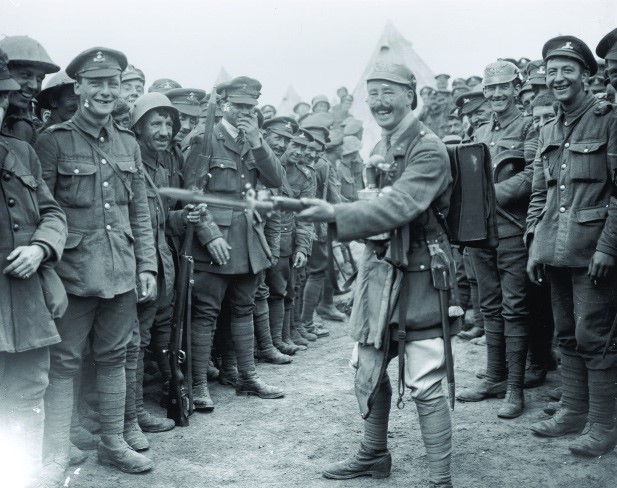
The Royal Dublin Fusiliers at Messines.
East Belfast & The Great War Research Project

